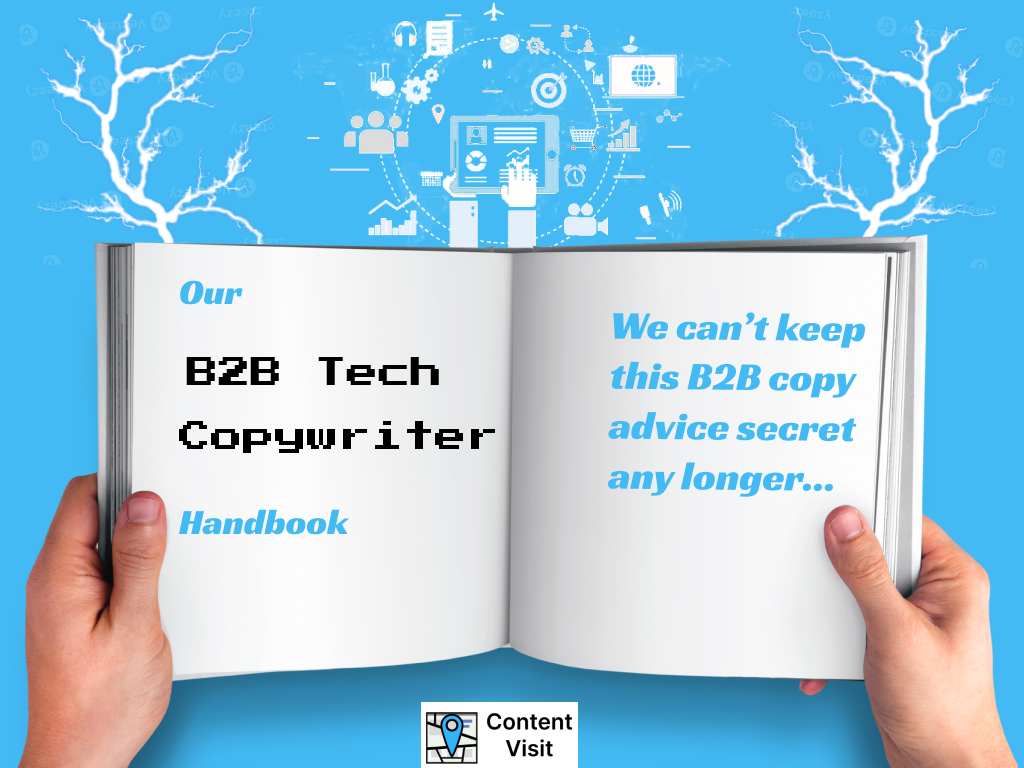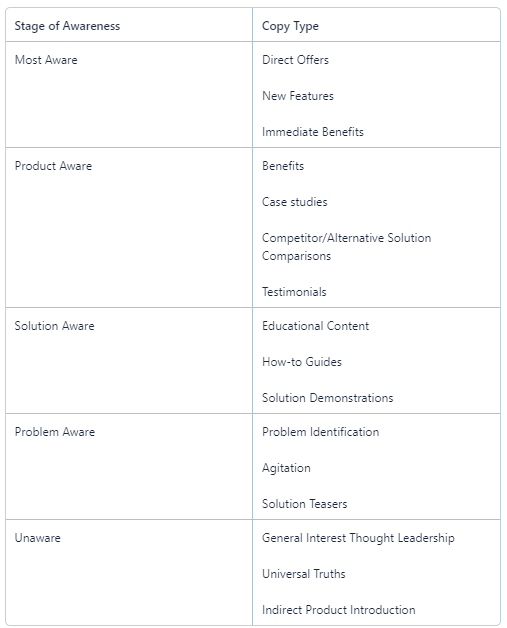
Our B2B Tech Copywriter Process
Table of Contents
- What You Can (And Can’t) Do with B2B Tech Copywriting.
- Awareness and Copywriting
- Our 9 B2B Tech Copywriting Tips
- 1. Intensify the idea you are selling
- 2. Identify your technology and product with people
- 3. Gradually introduce new ideas
- 4. Redefine your offer to get around objections
- 5. Use their language in your headlines
- 6. Point out weaknesses in the alternative solutions
- 7. Design your copy to be skimmable
- 8. Sell the fear they already have
- 9. Back up stories with stats
In this blog, we give away our B2B technology copywriter process.
Below, we share 9 tips that you can use to assess whether your copy will convert B2B tech buyers, create your own B2B conversion copy and gauge the ability of an agency or freelance B2B tech copywriter to write copy that converts.
Our process owes a massive debt to books like “Breakthrough Advertising” by Eugene Schwartz, Cashvertising by Drew E. Whitman, Content Design by Sarah Richards, wisdom from David Ogilvy, and an array of other copywriting knowledge.
We’ve adapted these mostly consumer-facing copywriting practices to the modern B2B technology market and used them to turn conversation rates from B2B content assets of 0.5% into 5%.
What You Can (And Can’t) Do with B2B Tech Copywriting
Successful B2B copy moves a buying team one step further towards signing a contract with your sales team.
However, copy (words) cannot create desire in a B2B buying team for your product or service. The desire for your solution already exists. You use copy (in whatever form) to tap into that desire.
Meeting a buyer's desire (for example, not having to worry about losing their job because their company gets hacked next quarter) starts with two things:
Deep knowledge of the specific desire the buyer has.
An offer (i.e., a solution you are selling) that satisfies it.
B2B marketing copy connects these two ingredients. It stops your prospect and compels them to read the second sentence in your PPC ad, turn over the page in your whitepaper, click on that email, or listen for a moment longer to the webinar you sent them.
Although the format (video, blog, solution brief, etc.) can vary, the topic will always depend on how aware your buyer is about your product.
Awareness and Copywriting
Even when selling to enterprise-level organizations, you are still selling to individuals with different levels of awareness about your company.
We define awareness as a B2B buyer’s willingness to choose you versus doing nothing or choosing one of your competitors.
See the table below for the different awareness stages and the kinds of copy a B2B tech copywriter should focus on to best match a person's level of awareness.

Our 9 B2B Tech Copywriting Tips
The 9 tips below are what we use to guide us when writing B2B copy that we hope will beat any baseline our tech clients use.
These steps are also a kind of health check for marketing copy that has already been written. Apply them to a single piece of copy or a series of copy assets, such as an email nurture campaign.
Disclaimer: We don't see copywriting as a formulaic process or an exact science. You can never guarantee that a specific piece of copy will perform to a particular level. A more realistic goal or KPI for a B2B tech copywriter is to take a likely conversion baseline for generic copywriting, which, in B2B tech copy and content, is typically around 0.x%, and aim to beat it.
1. Intensify the idea you are selling
Focus on one core idea in each copy/content asset.
Take that core idea and reinforce it. Each new line, paragraph, or section should give the idea a twist, reinforcing everything that went before it.
Drill into the idea, make claims, and show the reader your claims in action.
You want the reader to come away with a clear image of what you're selling and how it would look in their world.
2. Identify your technology and product with people
Figure out your prospect’s desire to act out certain roles in their career.
Who do they want to identify with, i.e., who do they want to be?
For example, a newly promoted CISO might buy a threat detection and response platform to reduce cyber risk in their environment—that’s what they say, at least. However, they will also buy a particular technology to identify with other seemingly successful CISOs who use it.
Your product’s main image is what comes to people’s minds when they think about it.
At the early stage of the buying journey, buyers will form images in their heads about how a particular service or product will fit their needs.
Weave favorable social and character images into your product's personality to bring positive images about it to the fore.
3. Gradually introduce new ideas
Never tell someone that what they think is right is wrong and expect them to believe you.
Even if you're bringing new tech to market that you know will transform how people in your sector will work, you cannot just tell someone their legacy technology is broken.
They’ve heard it all before.
You need to gradually explore someone’s current beliefs and reframe them in the context of what you’re selling.
Do this by:
Presenting “detailed identification.” Show the prospect you’ve been in their shoes. You must have done extensive research to know what this feels like. Being empathic with your prospect will pay off greatly.
Contradicting present (but false) beliefs. This is the typical “you think THIS is true, but I will show you why it’s false” type of statement. Instead of agreement, you want to loosen their existing beliefs.
Using the “Language of Logic.” This requires mixing a promise with its logical conclusion (which is great because you build belief while building desire simultaneously). Use expressions like “Sounds hard? Actually, it’s simple…” or “Here’s why…” or “Therefore…”
4. Redefine your offer to get around objections
Through most of the B2B buying journey, there are two core reasons a prospect is going to disengage with your copy:
The product is too complicated.
The product is not important enough.
Here's how to overcome these objections with redefinition:
Simplify: Find out which parts of your product your prospects consider complicated, annoying, or inconvenient. Don’t talk about them openly at the beginning. Instead, reframe what that issue means for them — for example, a “repair” becomes an “adjustment.”
Escalate: Give the product more importance by broadening the impact of its benefits. Do this by redefining the product's role in the prospect’s life or explaining its effects on their lives, especially where they least expect them.
5. Use their language in your headlines
Headlines tend to be an afterthought in B2B copy.
David Ogivily explained why headlines should be where your copywriting work starts, not where it ends:
“On the average, five times as many people read the headline as read the body copy. When you have written your headline, you have spent eighty cents out of your dollar.”
To create a great headline, use the words and phrases your prospect will agree with. You can find out what these are by researching your customers’ desires.
When you find customers’ desires, put them into your headlines.
6. Point out weaknesses in the alternative solutions
Contrast everything that an alternative solution or technology does bad, point by point, with:
a) Everything you do differently.
b) Everything you do that helps the prospect fulfill their mass desire.
You can also use case studies, testimonials, and other claims that intensify the feeling of your competitors’ incompetence.
Reverse everything the other techniques do—instead of selling your product or solution, you sell why the alternative course of action is bad.
7. Design your copy to be skimmable
Eye-tracking research shows that people do not read web copy in a straight line. They read in a zigzag. They skim your copy, looking for interesting bits, and then loop back to read the rest.
Your copy must hook the reader from one line to the next. It must also give them hooks throughout.
Two simple rules for doing this are:
Break up your copy into self-contained paragraphs.
Avoid using “The, This, That” at the start of sentences.
The reader should be able to start reading your copy anywhere and have the next few lines make sense.
8. Sell the fear they already have
Selling through fear is an overused copywriting trope, but it still works as long as it's done subtly and sparingly.
Most B2B tech copy should only talk about fears that customers already have. Don’t try to create new fears unless you gradually introduce them (see tip 3).
Be as specific as possible. For example, say, “Use an EDR to prevent info stealers and ransomware” rather than “Use EDR to stop cyberattacks.”
9. Back up stories with stats
When you state a statistic, back it up with a story. And vice versa.
Statistics on their own are meaningless and can cause readers to ignore the rest of your copy.
But stories alone are not a good fit for most B2B copy, either.
Stories can stir emotions, but when talking to B2B buyers, you also need to give them facts.
This both backs up your point and makes it easier for them to share your copy with others.
Hire B2B tech Copy Experts
Content Visit is a boutique tech and cybersecurity copywriting and content development agency. If you are technology company looking for support with your product marketing and sales enablement campaigns, let's talk.
Written by Laura Martisiute